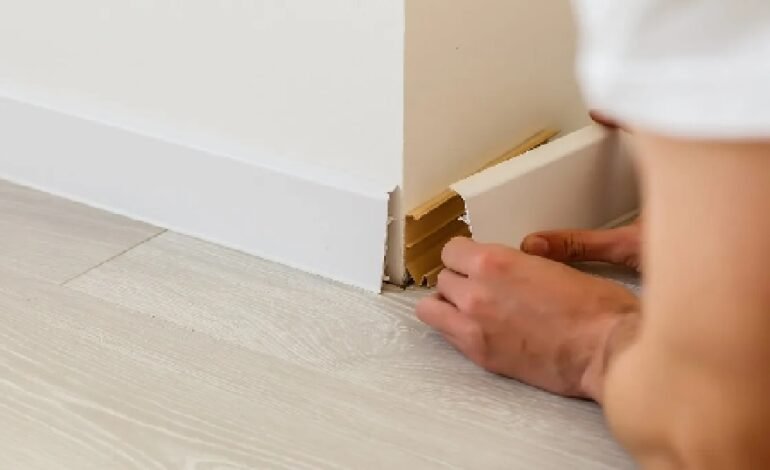“Choosing the Perfect Skirting Board: A Guide to Style and Function”

Imagine walking into a room and feeling an immediate sense of completeness. Often, this effect is achieved by the details—the seemingly small elements that pull a room together. One such detail is the skirting board. While it might seem like a minor aspect of interior design, the right skirting board can significantly enhance both the style and function of your space. But how do you choose the perfect one?
In this guide, we’ll explore everything you need to know about skirting boards. From understanding their purpose to selecting the right style and material, we’ve got you covered. By the end of this post, you’ll be well-equipped to make an informed decision that elevates your home’s aesthetic and practicality.
Understanding the Purpose of Skirting Boards
Skirting boards, also known as baseboards, serve several essential functions in a home. They provide a finished look to the junction between the wall and the floor, seamlessly covering any gaps left by flooring materials. Additionally, skirting boards protect walls from kicks, scuffs, and furniture, preserving the integrity of your paint or wallpaper.
Beyond their protective role, skirting boards also contribute to a room’s overall design. They can create a sense of balance, enhance architectural features, and add a touch of elegance or modernity depending on the style you choose.
Types of Skirting Boards
When it comes to skirting boards, there’s no one-size-fits-all solution. Several types cater to different needs and preferences. Here are some popular options:
Traditional Skirting Boards
Traditional skirting boards often feature intricate designs and detailed moldings. They work well in period homes and rooms with classic decor. Think Victorian or Georgian properties where adding character and maintaining historical accuracy is essential.
Modern Skirting Boards
For contemporary spaces, modern skirting boards offer a sleek, minimalist look. These typically have simple lines and less ornamentation, making them perfect for rooms with a more modern or industrial aesthetic.
MDF Skirting Boards
Medium Density Fiberboard (MDF) skirting boards are a versatile and cost-effective option. They come pre-primed, making them easy to paint and customize. MDF is also resistant to warping, which can be crucial in humid environments.
Choosing the Right Material
The material of your skirting board can impact not only its appearance but also its durability and maintenance requirements. Here are some common materials to consider:
Wood
Wooden skirting boards are a classic choice. They offer a timeless appeal and can be stained or painted to match any decor. However, they may require more maintenance, such as periodic painting or staining.
MDF
As mentioned earlier, MDF is a popular choice due to its affordability and ease of customization. It’s also resistant to moisture, making it suitable for areas like kitchens and bathrooms.
PVC
PVC skirting boards are another low-maintenance option. They are durable, water-resistant, and available in various styles. While they may not offer the same aesthetic appeal as wood, they are practical for high-traffic areas.
Selecting the Perfect Style
The style of your skirting board should complement the overall design of your space. Here’s how to choose the right one:
Height Matters
Skirting boards come in various heights, typically ranging from 3 to 8 inches. The height you choose should be proportionate to the room’s ceiling height and overall size. Taller skirting boards can make a bold statement in larger rooms, while shorter ones are more subtle and suitable for smaller spaces.
Color Coordination
While white is a popular choice for skirting boards, don’t be afraid to experiment with color. Matching your skirting board color to your walls can create a seamless look, while contrasting colors can add visual interest and highlight architectural features.
Installation Tips
Installing skirting boards might seem daunting, but with the right preparation, it can be a straightforward process. Here are some tips to ensure a smooth installation:
Measure Accurately
Before purchasing your skirting boards, measure the perimeter of the room accurately. Add a little extra to account for any mistakes or irregularities.
Prepare the Surface
Ensure the wall surface is clean and free from debris. If you’re replacing old skirting boards, remove them carefully to avoid damaging the walls.
Use Quality Adhesives and Fixings
Using the right adhesives and fixings is crucial for a secure installation. Follow manufacturer recommendations and take your time to ensure the boards are level and aligned correctly.
Maintenance and Care
Maintaining your skirting boards can extend their lifespan and keep them looking fresh. Here’s how to care for them:
Regular Cleaning
Dust and dirt can accumulate on skirting boards, so regular cleaning is essential. Use a damp cloth or a vacuum with a brush attachment to remove dust and debris.
Touch-Up Paint
Over time, skirting boards may get scuffed or chipped. Keep some touch-up paint handy to address minor imperfections as they occur.
Inspect for Damage
Periodically inspect your skirting boards for signs of damage, such as warping or cracks. Address any issues promptly to prevent further deterioration.
Trends in Skirting Board Design
Like any element of interior design, skirting boards are subject to trends. Here are some current trends you might consider:
Integrated LED Lighting
Incorporating LED lighting into skirting boards can create a modern, ambient glow in your space. It’s a stylish way to enhance both form and function.
Contrasting Colors
Bold, contrasting colors are gaining popularity. Pairing a dark skirting board with light walls, or vice versa, can make a striking design statement.
Textured Finishes
Textured finishes, such as wood grain or brushed metal, add depth and interest to skirting boards. They can create a tactile element that enhances the overall aesthetic.
Budget Considerations
Your budget will play a significant role in choosing the perfect skirting board. Here are some tips to ensure you get the best value for your money:
Plan Ahead
Before shopping, establish a budget and stick to it. Consider the cost of materials, installation, and any additional features you might want, such as custom profiles or finishes.
Compare Prices
Shop around and compare prices from different suppliers. Look for sales or discounts, and don’t forget to factor in the cost of delivery.
DIY vs. Professional Installation
Deciding between DIY installation and hiring a professional can impact your budget. While DIY can save money, professional installation ensures a flawless finish and can save time.
Environmental Considerations
If sustainability is a priority for you, consider the environmental impact of your skirting board choices:
Sustainable Materials
Look for skirting boards made from sustainable materials, such as FSC-certified wood or recycled PVC. These options minimize your environmental footprint.
Non-Toxic Finishes
Choose skirting boards with non-toxic finishes and adhesives. This ensures a healthier indoor environment for you and your family.
Longevity
Investing in high-quality, durable skirting boards reduces the need for frequent replacements, contributing to a more sustainable home.
Case Study
To illustrate the impact of choosing the right skirting board, let’s look at a case study:
The Modern Makeover
A young couple wanted to update their living room with a modern, minimalist look. They chose sleek, white MDF skirting boards with a bullnose profile. The result was a clean, cohesive space that felt both contemporary and inviting. The skirting boards not only protected their walls but also added a finishing touch that tied the room together.
Conclusion
Choosing the perfect skirting board involves considering various factors, from style and material to installation and maintenance. By understanding the options available and matching them to your needs and preferences, you can transform your space into a harmonious and aesthetically pleasing environment.
Read more: https://newpawsibilities.com/












